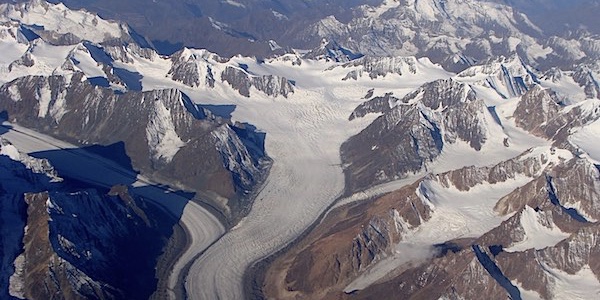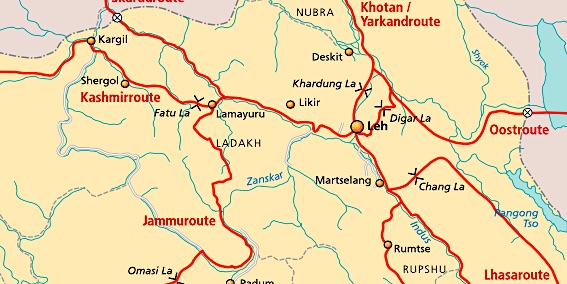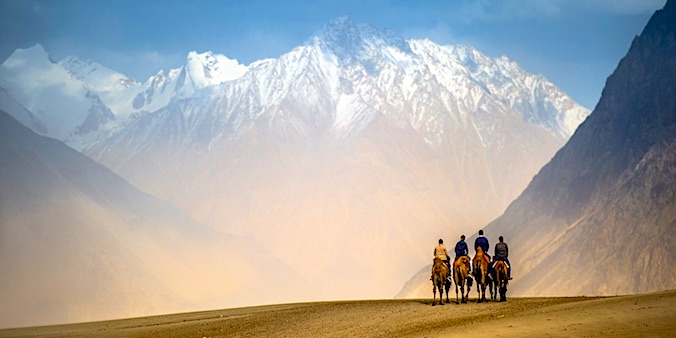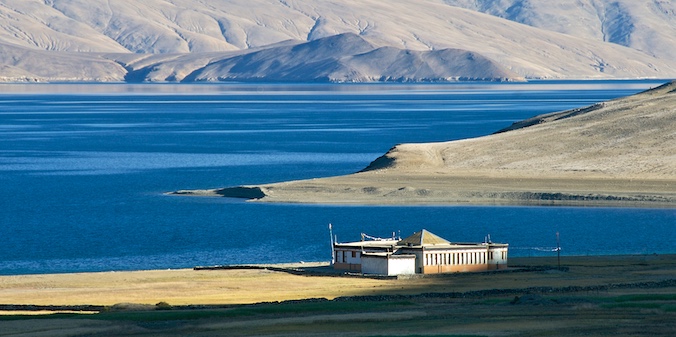THE ROUND of LADAKH
Bicycle Tour - 20 days/ 15 days bicycling
THE ROUND of LADAKH
20 days tour/ 16 days bicycling
About LADAKH
Ladakh is a part of the Indian Himalayas, located between the main Himalayan Range in the south and the Kunlun and Karakoram Range in the north. As it is the only Indian region that lies north of the Great Himalayan Range, it is very different from the rest of the Indian Himalayas. In many ways it resembles Tibet. Although part of India now, and earlier part of the princely state of Kashmir, Ladakh has been an independent kingdom for almost 900 years.
Ladakh is best known for its ‘Tibetan’ culture and its starkly beautiful mountain scenery. It is inhabited by a mix of Indo-Aryan and Tibetan people. Especially the latter, with their colorful Buddhist culture, have given the region the nickname of ‘Little Tibet.’
MOUNTAIN RANGES AND PASSESLadakh is not just high, its very mountainous as well. North of the Great Himalayan Range, three other mountain ranges define its geography. The Zanskar Range separates Ladakh proper – the Indus Valley with its capital Leh – from the valleys of Zanskar, where 10,000 people still live in relative isolation. North of the Indus Valley, the Ladakh Range separates Ladakh proper from the Nubra Valley. This area is bound and separated from Pakistan and China in the north(east) by the Karakarom Range and the uninhabitable Aksai Chin Plateau.
As a result of its location, in the rain shadow of the Great Himalayan Range, the climate of Ladakh is extremely dry. And due to the high altitude – most valleys are situated at 3300m or higher – winters can be extremely cold. Summers, however, are generally pleasant if not warm and sunny.
Read more…Read less…
The remoter areas of Zanskar, Nubra and Rupshu (also called Changtang, in the southeast of Ladakh) can be visited from Leh by car, on foot (trekking) or by bicycle. Trekking or bicycling would be our advised means of transport. That is, if you are up to it. Because, while jeep trips in Ladakh are very rewarding indeed, trekking and bicycling will give you an even more in-depth experience of the land and the people, with the added bonus of a total renovation of body and soul.
Ladakh can be reached by air or overland. On this tour, you fly in and out. In case you have enough time available, we strongly recommend taking one of the overland routes, in which you travel by train and car to Ladakh through Srinagar in Kashmir, Manali or Shimla, the latter two both in the Himalayan state of Himachal Pradesh. These are among the greatest car journeys in the world.
Region
Ladakh
(India)
Best Time
July. - Sept.
No. Of Days
20 days,
15-day bicycle tour
Trip Character
Bicycle tour
Sleeping Altitude
3100 - 4595 m.
Trek Character
Homestays & guesthouses
Bicycle tour: level 3
Price
INR XXX/ $ XXX
ABOUT THIS TOUR
On this tour, you’ll explore the majestic mountains and remote idyllic villages of Ladakh by bicycle. Going at your own pace along millennia-old caravan trails and interacting with the utterly friendly and contented Ladakhi people, while staying at home-stays, you’ll see and experience so much more of this fairy-tale country than the jeep-sitters will.
Ladakh is situated on the Tibetan Plateau, and it’s high. The altitude will force you to go slower than you are used to back home, but that only adds to the experience. There is no hurry on this trip. Being on the trail, winding your way up to a high pass with majestic views and coming down again to be greeted by cheerful kids and waving prayer flags, that’s what it is all about. You’ll have your back-up car to make the ride easier or shorter if you want.
Depending on your time window, you may also be lucky enough to witness one of the spectacular, colourful and mystical Buddhist festivals, called tsechus, where monks dance in brilliant costumes wearing ancient masks of gods, demons and mythical animals. If the dates coincide, we’ll make sure that you are able to squeeze in a fantastic festival on this holiday as well.
YOUR custom-made TRIP
The tour described here, as well as the other ones on our website, are mainly meant as suggestions. We would be happy to offer you a travel proposal that fully meets your personal demands and expectations. That means that you choose where you want to go, what level of accommodation and type of transport you want and what activities you prefer.
Please let yourself be inspired by this and other trips on our website and then drop us a line (or call us) to explain your travel wishes. We will be happy to help you put together the perfect trip. You can reach us over e-mail, Messenger, Whatsapp or mobile phone.
EXTENSIONS & VARIATIONS
Apart from the tour as described here, you could consider the following add-ons and changes:
- Spend one or two more days in Sham (lower Ladakh) cycling through beautiful oases amidst colourful mountains.
- Explore the Shyok River further downstream in the direction of Pakistan. The road passes through magnificent gorges and while the vegetation gets more opulent as you are reaching lower altitudes the culture gradually changes from predominantly Buddhist to Muslim. You can travel up to the village of Turtuk where you can stay the night at a simple but decent tented camp.
- Spend one more day in Nubra on which you make a 5-hour walk to two small, hidden monasteries that rarely if ever see a foreigner coming.
- Spend a day rafting on the Indus. There are different grades available, so there is the easy but fun to do level as well. Professional oarsmen will be with you in any case. You will be picked up from your hotel and dropped off there again at the end of the day, a picnic lunch is included.
On this trip, you will have your bicycles with you at all times, as well as a pick-up truck. This gives you ample opportunities to make small side trips from any of the places that you visit.
Route Map
ITINERARY
-
Day 1: Flight Delhi - Leh
The flight from Delhi to Leh takes only 1 hour but on a clear day, is breathtaking. Stepping down from the aircraft you may feel the altitude, but even if you don’t, it is very wise to take the rest of the day off. Stay at the hotel or at best walk around Leh bazar. Altitude: 3500m. -
Day 2 & 3: In Leh
If you wake up today without a headache you may consider yourself fit to go on not too strenuous walks/excursions in and around Leh. Else it is better to stay at the hotel another day. Altitude: 3500m. -
Day 4 - 6: Biking the lower Indus Valley (196 km in 3 days, +3635m, -3635m)
Your first three days of cycling will be a relatively easy tour of the Indus Valley northwest of Leh. You’ll cycle to the pleasant village of Likir where a magnificent gompa sits atop a hill. Other monasteries, such as Spituk and Basgo, fall on the way. This is partly uphill, partly downhill cycling. The next day you’ll continue, almost all the way downhill, to Ladakh’s oldest temple, Alchi Gompa on the other side of the Indus. From here you return to Leh. Altitude 3500 → 3650 → 3100 → 3500m. -
Day 7: In Leh
A relaxing day in Leh, maybe buy some souvenirs and check out the museum and some garden restaurants in town. Altitude 3500m. -
Day 8: Leh – Khardung La - Hundar (car/ biking 125 km, +2650m, -2930m)
As climbing up world’s highest motorable road by bicycle so early on in this trip may not be everyone’s cup of tea, we suggest you and the bikes ride the accompanying pick-up truck upto the breathtaking 5450m high Khardong La. Once on the bikes, a whopping 2300m descent eventually lands you in the Nubra valley. After some level coasting along the banks of the wide, gushing Shyok River you’ll reach Deskit, the cute little capital of Nubra, and nearby Hundar, a lush small enclave hidden away among apricot groves.. Altitude 3500 → 5450 → 3100m. -
Day 9 & 10: In Nubra (biking approx. 90 km, +1120m, -1120m)
The coming days you can decide in consultation with the guide/driver which parts you want to cycle and where you prefer to ride the pick-up. Today and tomorrow you’ll stay at guesthouses in Hundar and Sumur, from where you can make day excursions down the Shyok River in the direction of Pakistan, up the Nubra River to the pleasant hamlet of Panamik, or visit some of the magnificent gompas closer by. Altitude 3100 - 3200m. -
Day 11: Sumur - Tanggyer (biking 54.5 km, +1305m, -590m)
Follow the wide Shyok River upriver until Khalsar, then continue on a very little used road along the riverbank. The sheer vastness of the valley and its colourful mountains, interspersed with tiny green patches of irrigated fields and villages is very spectacular. The gradual ascent is very doable, as is the last 10 km stretch till Tanggyer (450m climb). Tanggyer is a very picturesque village with a small monastery on a ridge. Staying in tents (provided by us) or in a very simple home stay. Altitude 3130 → 3750m. -
Day 12: Tanggyer - Wuri La - Takthok (biking 51 km, +1525m, -1555m)
Today is the most serious one of this tour. The climb to Wuri La at 5250m is tough, but you can take regular breaks and enjoy the pastures where yaks and wild marmots graze. On the pass you’ll be rewarded with spectacular views of the Sakti Valley, Indus Valley and the Zanskar Mountains behind it. From here you coast down to a comfortable home stay in Takthok, located in a remote side-valley of the Indus Valley. Altitude 3750 → 5300 → 3700m. -
Day 13: In Takthok
If you wish you can explore the magnificent valley near Takthok, either on bike or on foot. For instance, you can visit the small but significant gompa and cave in the village. Altitude 3700m. -
Day 14, 15 & 16: Takthok - Korzok/ Tsomoriri (191 km in 3 days, +3100m, -2355m)
The next three days will take you through some dramatical differences in landscape. First you roll down an easy road to Karu (3500m), where you reach the main Leh-Manali Highway. From here you follow the Indus River upstream in the direction of Tibet along the deep gorge that the river has cut here for another 40-60 km, depending on your fitness. It is steady but gently climbing all the way till Mahe Bridge (4170m), which you’ll reach the next day. Here you’ll cross the Indus and follow a deserted road to your camp in Sumdo (4500m). The third day you’ll enter the vast and colourful plains of Rupshu, part of the western Tibetan high altitude plateau called Changtang. You follow a small surfaced road that gently climbs to a pass at 4960m, after which you descend to the small lake Kyagar Tso. After this it is more or less level riding till Korzok on the shores of Tsomoriri (4595m). Altitude 3700 → 3500 → 4170 → 4960 → 4500 → 4595m. -
Day 17: At Tsomoriri
The day can be spent lazing by the lake, visiting the local gompa, walking along the shore or bicycling down to its southern tip at Kyangdom, a scenic place (40 km up and down). Altitude 4595m. -
Day 18: Tsomoriri – Tsokar Lake (86.5 km, +1160m, -1140m)
You cycle back to Sumdo, then go west on a less travelled road, gradually climbing past some hot springs up to the Polokonka La pass (4970 m). After an easy descent you enter a vast plain, the Wildlife Sanctuary of Tsokar Lake, and reach your tented camp near Thukche Gompa. Altitude 4595 → 4970 → 4530m. -
Day 19: Tsokar – Leh by car (140 km/ 6-8 h)
From Tsokar you return back to Leh by car, following the Manali-Leh highway over the 5300m high Taglang La. However, if you wish, we are most happy to arrange another 2 or 3 days for bicycling back. Altitude 4530 → 5300 → 3500m. -
Day 20: Flight Leh - Delhi
Early morning transfer to the airport. On a clear day, again, you can expect (again) great views of the mountains of Zanskar and the Great Himalayan Range.
HIGHLIGHTS OF THIS TOUR
Flight to Leh


LEH
CARAVAN ROADS OF LADAKH


SHAM AREA
LOWER INDUS VALLEY (WEST)


LAMAYURU & ALCHI GOMPA
Khardong La


NUBRA VALLEY
SALTY LAKES OF CHANGTANG




